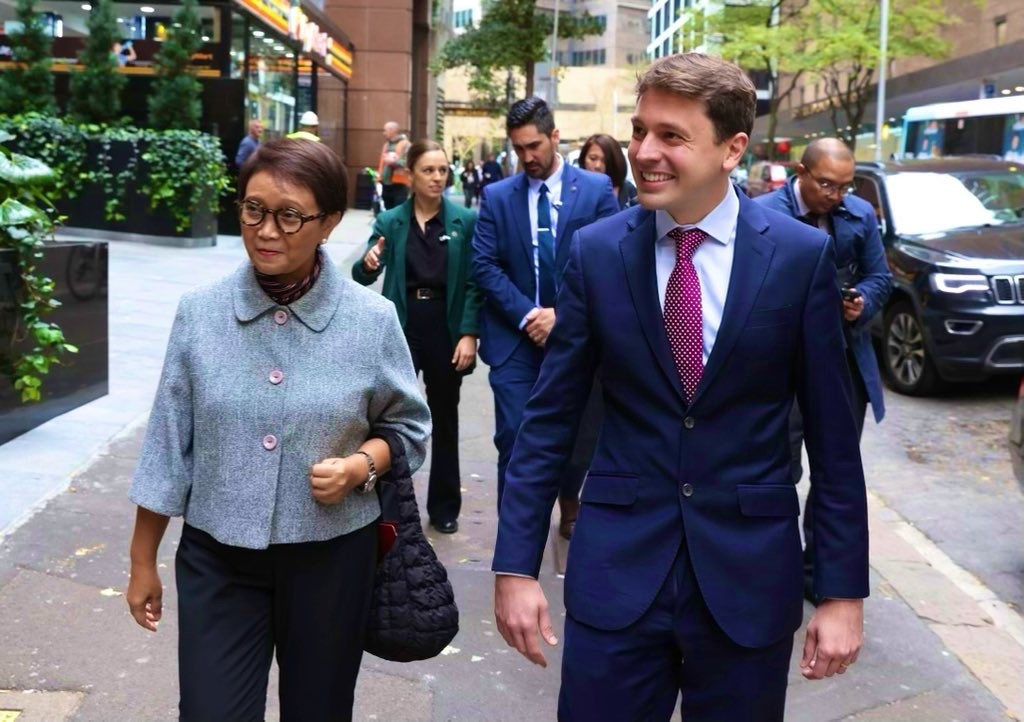What are five flashpoints and world trends to watch?
This interview was originally published by Felicity Lewis, national explainer editor at The Sydney Morning Herald and The Age, in the mastheads' weekly Explainer newsletters.

Not many people can say they spent their childhood following the opium trade around the world. Yet this was the trajectory of Hervé Lemahieu, who I’d like to introduce you to this week. Hervé is director of research at Lowy Institute, an independent international policy think tank based in Sydney. I got in touch with Hervé earlier this week because my head was spinning with the seismic events and simmering tensions that have come across the Explainer desk in recent times. I explained to Hervé that I would like to ask him a few questions, just casually, as if we were at a dinner party. It turned out to be a metaphorical “late night” as he shared his personal story and his thought-provoking insights into the world today.

Hervé was born in Belgium but in this photo, above, he’s in Seoul (standing between his parents), in the early 1990s. “Dad was just starting off as a junior professional officer with the UN Industrial Development Organisation,” says Hervé, “a generation ago, when South Korea was still a developing economy!” When his father moved to the UN Office on Drugs and Crime, the family moved too: first, to the Caribbean nation of Barbados, a transit point for drugs between North and South America; then, a few years later, to Myanmar, where the Golden Triangle is the world’s biggest opium producer. “My dad later headed up the counter narcotics effort in Afghanistan but by that point I was at uni. I would visit him for epic Afghan road trips. So, yeah,” he adds, with more than a touch of understatement, “an interesting background.”
It’s little wonder that Hervé’s own working life has been about all things geopolitical. After studies at Oxford and St Andrews in Britain, and roles at a different think tank and at a geopolitical advisory firm in London, Hervé came to Australia where he is now a Belgian-Australian citizen and leading some fascinating research at Lowy. So, readers, may I offer you a glass of wine or a cup of tea before we get started?
Hervé, what are people asking you about right now?
Everyone’s always drawn to the US election. That’s the big one. I think the bigger picture here is that the world’s three largest democracies – the US, India, Indonesia – have had, or are about to have, elections this year. If Donald Trump comes back to power, they will all have leaders who are sympathetic towards Vladimir Putin. So, an over-simplified narrative of a world divided into autocratic and democratic blocs doesn’t quite stack up. I think democracies are far too complex for that. In the US, there’s a question around whether the institutions of democracy – not just the presidency but Congress, the judiciary and the Supreme Court – can withstand the challenge of Donald Trump and populism.
Will the far right prevail in Europe in the long run?
Often you have to wait for the election results before you can come up with a firm view about which way the wind is blowing. Clearly, there is still a majority of French who cannot stand the idea of the far right coming to power, but they’re left with this problem of the centre and the left not being able to find a means of working together. Every election cycle, we’re seeing the far right incrementally gain ground. They’re obviously very good at channelling real frustrations. The answers they prescribe, though, are far too simple.
But also, just thinking out loud, by refusing to engage with the far right you are contributing to fetishising them. I mean, part of their popular appeal is that they look like the underdogs, and the elite are doing everything possible to keep them out. Look at Italy. Its new prime minister, Giorgia Meloni, has actually become a much more normal leader since coming to power. Often these guys have an air of invincibility, and it’s not ideal but her being in power dissipates a lot of the allure. Even the far right have to contend with basic realities of governing.
In Lowy Institute’s annual poll of Australians, 17 per cent said they trusted China “somewhat”. Six years ago, it was 52 per cent. What do you think Beijing thinks about that?
I think Beijing has taken stock of those results. Part of the success that this government has had in stabilising relations with China is not just the ingenuity and discipline of Penny Wong as Foreign Minister. There’s also a recalibration in China. They are dialling back on their wolf-warrior diplomacy. They know trade coercion hasn’t had the intended effect – I think they were hoping it would scare the bejesus out of Australian businesses and apply pressure on politicians to capitulate, which never happened. In the West, attitudes towards China have really deteriorated as a result of the hubris we’ve seen from Xi Jinping over the last five years. So the Chinese are presenting a bit more humility – but they’re also playing a long game. Australians now see China, by and large, as more of a security threat than an economic opportunity.

This photo shows you with Indonesia’s Foreign Minister, Retno Marsudi, last year. You more recently travelled to Malaysia, Vietnam, Cambodia and South Korea. Any observations?
One is, just how remarkably spoiled we are in Australia to have the kind of geography that we have. If you think about South Korea, it literally has its back to a nuclear power, North Korea. It’s also proximate to Russia and China. It’s got difficult historical ties with Japan that it’s still resolving. I mean, they’re really up against it in ways that we simply are not. Australia, let’s be frank, is surrounded by friends and fish. We’re an island continent. Of course, we’re worried about our strategic circumstances. Of course, we’re worried about China. Australia has an acute threat perception. But, in terms of our exposure to geopolitical risk, in so far as we’re dealing with China’s growing presence in the Pacific Islands region, or elsewhere, we’re simply becoming more “normal”, less strategically exceptional.
The second observation is that while we’re all fixated on China and the fortunes of the US, another seismic trend in world affairs is the rise of middle powers. In the Middle East, you have some rogue middle powers such as Iran, Syria, even Saudi Arabia, and you’ve got the Russians, playing a very kind of dirty game of proxy warfare. Aren’t we lucky that we have the likes of Indonesia and Vietnam in our parts of the world? They try to hold things together, despite US-China competition.
Vietnam, for example, has managed to sign a comprehensive strategic partnership deal with the US. Yet their ties with the Chinese Communist Party are still incredibly robust. They’re trying to find an equilibrium. Both the US and China have to work hard to keep them on side. In that sense, Vietnam is a tail that wags the dog. Indonesia is playing a smart game too. Think about the fact that Jokowi hosted the G20 last year and was able to facilitate a meeting between Joe Biden and Xi Jinping that was the starting gun to this period of strategic reprieve, or stability, between the US and China.
What are five parts of the world for us to keep an eye on?
1. Definitely, the South China Sea and the risk of accidental military conflict there. I think that is probably a more near-term risk than a Taiwan scenario. I mean, if the Chinese prevent the Philippine Navy from restocking the Sierra Madre – which is that stranded Philippine Navy vessel in the Second Thomas Shoal in the South China Sea – how far will the Philippines go? I think they will, at all costs, try to resupply their crew there. We’ve already seen it come to blows, literally, daggers drawn. They’ve got axes. They haven’t shot at each other but people have been injured. We’ve also seen Australian Navy ships and aircraft being targeted by China. That sort of “grey zone” coercion is something that could become a fully-fledged conflict very rapidly.
2. The India-China border is another one. India’s land border with China complicates China’s calculus for any kind of war scenario.
Well, Hervé, we’ve seen troops from China and India in hand-to-hand combat on the disputed border in the Himalayas.
Exactly. It’s obviously a big point of tension between India and China. In a war that involves China in East Asia, China would still have to watch its western flank. The moment that China mobilises for war, even if it doesn’t directly involve India, it would, according to Indian sources, trigger a mobilisation on the disputed Indian border. The logic of escalation is that if China mobilises for war, India mobilises for war, and that would distract from the ability of China’s military planners to focus exclusively either on the South China Sea or Taiwan.
3. Another place to watch, in the Indo-Pacific, is Papua New Guinea. PNG is a massive country on our doorstep. It’s the land bridge between the Pacific Islands and South-East Asia and Asia. Its government has come under sustained pressure by the opposition. The collapse of its government, or outright state failure, would be a low-probability but high-impact event.
4. Much further afield, I’d look at countries seeking to join the European Union. I think one of the consequences of Russia’s move on Ukraine has not just been that Finland and Sweden have joined NATO, but that a bunch of smaller Eastern European countries – including Georgia, Moldova, Albania, Serbia – are really accelerating their talks to join Europe. I’m convinced that the origins of the war in Ukraine lie in Russia’s anxiety not with NATO expansionism, but the success of the European project. All Russia is left with is to resort to military power, to be a disruptor, an arsonist of the international system.
5. Then, longer term, there’s the demographic transition in Asia. We’ve grown accustomed to seeing the economic success of the so-called “tiger economies”. They all took off when they were experiencing a youth bulge. That’s drying up very quickly. China’s loss of economic altitude is not cyclical, it’s structural, and it’s going to accelerate. But it’s not just China. It’s also Singapore, Vietnam, Thailand, South Korea. It also goes to show why Australia is the “lucky country”. It’s not just our geography, it’s our demography. Australia is in that Goldilocks zone of being a rich country that’s still growing its working-age population as a result of migration. That’s not to be sniffed at. It’s really a magic weapon.
The Sydney Morning Herald and The Age Explainer newsletter is published weekly.
Subscribe to The Sydney Morning Herald Explainer newsletter | Subscribe to The Age Explainer newsletter
